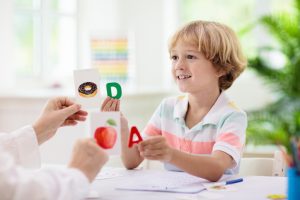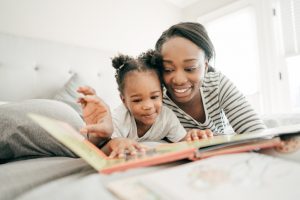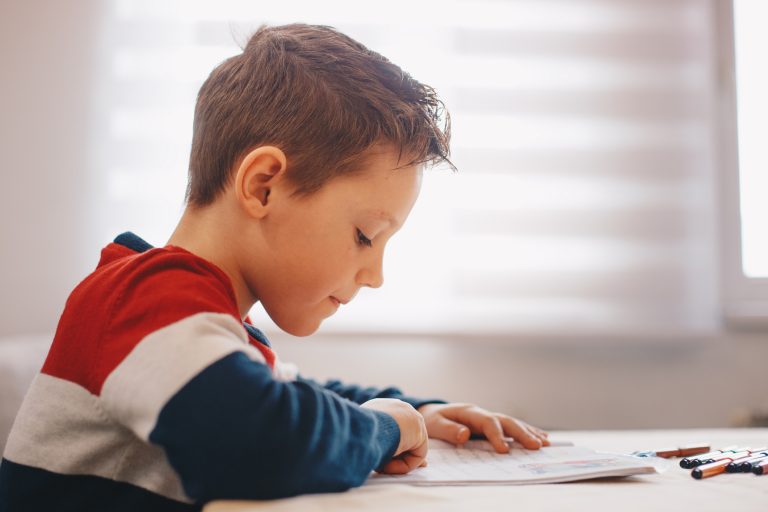Dyslexia is a word we hear thrown around often, but many parents don’t fully understand what it means or how to recognize it. If your kids are struggling to read, and you’re worried that these struggles may be beyond regular development, then you’ll want to read on! We asked Heather McNulty, a reading expert, to help us break down the reading process. Here are the signs your child may be dyslexic, what to do next, how to advocate and tips on successfully helping your kids learn to read.
In fact, even if your child isn’t dyslexic, you’ll probably find this very helpful as your little ones start to learn to read, enter kindergarten and take an interest in reading. So arm yourself with these tips, and you’ll find you and your little one will have a smoother transition into the literary world!
So, what is Dyslexia?
Dyslexia “is a neurologically based condition that affects word-level reading accuracy, reading fluency, and spelling. It is often described as an unexpected difficulty in learning to read.” (IDA – https://www.idaontario.com/about-dyslexia/)
When we are learning how to read, our brain is mapping words (orthography, the art of writing words with the proper letters according to a standard set of rules). We are taking the sounds we know and connecting them to their matching letters and then learning that when blended together, those sounds create a specific word. For example,
/k/ /a/ /t/ – sounds
c a t – letters
Caaaat – blending to hear the word
Cat – reading the word.
Children/adults who are dyslexic can have a very difficult time with this. Typical children need to be exposed to a new word 4 -14 times before it should become orthographically mapped. While children who have dyslexia require 14 – 200 exposures to map the same word.
When you’re reading with your small children, you know how repetitive it can be. They seem to be able to read a word on one page but then don’t recognize it on the next. This means they haven’t yet orthographically mapped that word and need more exposure and support with sounding it out.
It really can be like they are seeing it for the first time, even if they just read it one page before. Working with beginning or struggling readers is hard work. It requires lots of patience, time and repetition, repetition, repetition. So, as frustrating as it can be to hear them mix up a word repeatedly, it’s all a part of the process.
How is dyslexia diagnosed?
There isn’t a test for dyslexia. A child will need to take a psycho-educational assessment through a psychologist. These are expensive to do on your own, and there is often a very long wait time in schools. Most children don’t get one until they are in grade 3 or higher, which is much too late for our students with dyslexia.
Many school districts are getting on board with universal screening, which can’t give a diagnosis, but does share detailed information about what children struggle with when they read.
For example, in Canada, The Ontario Human Rights Tribunal released the Right to Read Report, and the government is slowly making changes. It’s an interesting read and helps us understand our and our children’s rights.
Is there a link to parents?
Yes! Most children with dyslexia have parents that struggled with reading as well. Think back to your childhood. Was reading easy for you, or did you struggle with it? Looking at your reading experience can help to make sense of your child’s.
Signs your child may be dyslexic vs. normal reading development?
Signs of dyslexia start from a very early age, but some children have excellent coping strategies, so it is harder to tell. One day their coping skills won’t be able to hide their deficit anymore, which is why universal screening at a young age is so important.
This is not a conclusive list, but here are some common struggles kids with dyslexia experience; reading through this list may help you understand whether your child is experiencing normal development or maybe dyslexic.
Common struggles your child may experience:
-Remembering the alphabet
-Learning the letter sounds
-Struggles with rhyming words
-Writing phonetically (spelling Cat like Lex instead of Kat or Kt)
-With oral wordplay (sun – light, what words does that make?)
-Letter formation – may write slower and/or messier than peers.
-Uses the pictures to guess at words (sees a horse, word starts with p – says horse, not pony)
-Blending words together (it’s like they have forgotten what the first sound was by the time they get to the last sound so the word they say isn’t close to the printed word)
-With reading comprehension (they are spending so much time trying to figure out what the text says that they are unable to understand it)
-Decoding words (they may rely on guessing or will mumble words even if this is a word you think they should know)
What next steps should I If I see signs my child may be dyslexic?
First things first, rule out or correct a physical problem, like needing glasses. The school will ask for this, so it is better to be prepared.
Get your child’s eyes checked by an optometrist.
Get your child’s ears checked by an audiologist.
Tell your doctor that your child is having trouble with reading (they may have support for you).
Talk to your child’s school. Set up a meeting with the teacher and let them know about your concerns and ask them how they will support your child.
Ask about what testing is available at the school level. How long would a waitlist be for a psycho-educational assessment?
Visit the International Dyslexia Association website for your area. They are a wealth of information, which can be overwhelming. So take breaks and read small amounts at a time.
Research. There are many amazing programs out there that can help support you and your child. There are also many terrible ones, so do your research by reading reviews, call places and asking tough questions. Join dyslexia groups on Facebook and read what others have to say.
Stay calm. You cannot solve this overnight. Reach out and find support through a friend or group. You can do this. You have already started just by reading this article and with that one small step, you are already changing your child’s reading life!
Talk to your child. Let them know that struggling to read isn’t their fault, that their brain is wired differently, and that they just need more support when learning to read. Do let them know that it will be hard work, and they will probably get frustrated. But by persevering, they too can become readers. Many famous people have dyslexia, including Steven Spielberg, Keira Knightly, Walt Disney and Steve Jobs, and they all went on to do amazing things!

How to advocate for your child at school:
For many years, teachers and educators were told and believed a few falsehoods like,
Struggling with reading will improve once they are in grade 2.
More time is what your child needs.
Boys develop slower at reading, and he just needs more time.
Unfortunately, this is still prevalent throughout the schools, though many great teachers are working on further educating ourselves and others.
Your child will not magically become a reader in grade 2, or when they lose their first tooth. More time is the opposite of what your child will need. Your son does not develop slower and needs more time. Your child needs action. The earlier a child with dyslexia receives support, the easier it is to close the gap.
This doesn’t mean your older children are out of luck; it just means they and you will have to work harder at bridging that gap. Talk to your child’s teacher. (Bring someone with you to take notes). Tell them about your concerns and ask what extra support they can provide for your child.
Be kind. Your children’s teacher should want what is best for them, but they may not know about the science of reading/how to teach to dyslexics or they could be just learning about it. We don’t know their journey.
Ask for extra small group/individual support, even if it is only for 10 minutes a day. Your child will benefit from explicit and systematic teaching of phonics.
Check to see if they offer after-school tutoring at your child’s school, and sign up if you are able.
Check to see if they offer online support through apps or programs purchased by the school district.
Ask for follow-up meetings. You want to stay on top of this.
Ask to see what beginning and ending assessment they will use and how they plan to progress monitor your child. Allow for 4-6 weeks, and then at the next meeting, ask to see the first assessment again to compare to where they are now.
Don’t take no for an answer. You know your child best. If you are not satisfied with the meeting, let the teacher know you will be booking another meeting with the Learning Resource Teacher (or SERT) to find ways to support your child with reading.
Remember, working with the school and teacher as a team will accomplish a lot faster. Be firm. Know your truth, and do not give up. You are your child’s biggest supporter, loudest cheerleader and fiercest protector.

How to help your child at home:
Start Small:
The chance that your child will not want to read with you or have you teach them is very high, especially after a full day of school where they struggled. Reading takes a lot of work and makes dyslexic brains very tired. Start small. Really small if you must.
Break words apart, and make it fun:
Dyslexics struggle with phonological awareness (PA), which is the skill of manipulating words orally. Like being able to orally identify the first, middle and last sound in a word, hear and produce rhyming words, break apart words into syllables and then put them back together again, and manipulate sounds in words (adding a new sound, deleting a sound or changing a sound). Starting with PA can be a fun low-stakes way to start working on reading, without working on reading. While you are eating, you could say:
“hey… what would fork say without the /f/” and let your child think of the answer; if they can’t, give it to them “ork, isn’t that funny! What about cup? What would cup say without the /k/?”
Do a few and see how they do. You could do this on the way home, on a walk, just before bed. Just do a few at a time using simple words at first.
Say the sounds not letters:
Instead of singing the alphabet, sing the sounds (short vowel sounds) and match them to the letters. This might mean relearning how you say sounds. When we say the sounds of the letters, we tend to add what is called a ‘schwa’ to the end of the sounds. So /k/ sounds like c-uh and /p/ sounds like p-uh. Saying that added ‘uh’ at the end can make it very difficult to transition to blending – /k//uh/ /a/ /t//uh/ is much harder to blend into cat than /k/ /a/ /t/.
Play “I hear with my little ear”:
Play ‘I hear with my little ear’ – just like I spy, but with sounds. Use simple CVC (consonant, vowel, consonant) words to start, like cat, dog, cup, and pup. But avoid tricky words like tea ( /t/ /ea/, /b/ /oy/)
I hear with my little ear something that sounds like: /g/ /a/ /p/
Support your child with blending those sounds together if they struggle longer than 5 seconds. We want them to feel successful and have fun!
Decodables:
You may have heard this term floating around. Decodables are books that are easy to decode/read. They are books that your child should be able to sound out almost every word. Decodable books follow a plan of what letters/sounds should be taught in what order. This means that to read the book, your child must have been taught what that letter is and what sound it makes.
As an adult, these books will look and sound dreadfully boring. But to a child who can’t read, it is magic. It may be the first time that they can read a whole page or book by themselves, and their excitement will be palpable.
Remember that they may not be able to read the book the first time through, or second, or third. This may be a book that you and your child read every single night for a week or two. Or longer. Until they feel like they have mastered it. How will you know if it’s mastered? They read it fluently (like they are talking) and don’t have to stop to sound out many if any, words. Rereading texts is one of the best things you and your child can do. It helps them orthographically map those words, helps them with their fluency (reading like they are talking), and gives them confidence that they can read.
Go Slow:
When you are reading with your child, and they have to stop to sound out a word, allow them the time to sound it out and blend it together. Then make them read that word to you again. Ask them to start the sentence over. Only move on once they are able to read that sentence 100% accurately. This may mean you only read one page of the book. That is fine. They are working hard, and so are you. Be proud!
Giving compliments is something we just do as parents. You are so smart, you are so kind, how clever you are etc. When reading with our children, we want to continue that. However, we want those compliments to correlate directly to something they did. Try not just to say ‘good job’ but quantify it with something they did. “Good job rereading that word without me asking!” “I love how you pointed at each letter and said the sound” “Isnt that amazing that you could just read that word!”
Make it fun, and don’t stress.
Here are some great resources parents might find helpful:
Resources to Google for Phonological Awareness:
David Kilpatrick’s One Minute Drills
Heggerty (this is a program, but you can download samples)
Resources for games:
Teach your Monster to read – APP
https://pbskids.org/games/reading
Decodable Resources:
BOB books (available at Indigo and sometimes Costco)
https://halfpintkids.com/ (free online decodables as of 2023)
https://portal.flyleafpublishing.com/learners-resources/ (free online decodables as of 2023)
For more Back-to-School posts in the Mabelhood, check out or School Hub!

